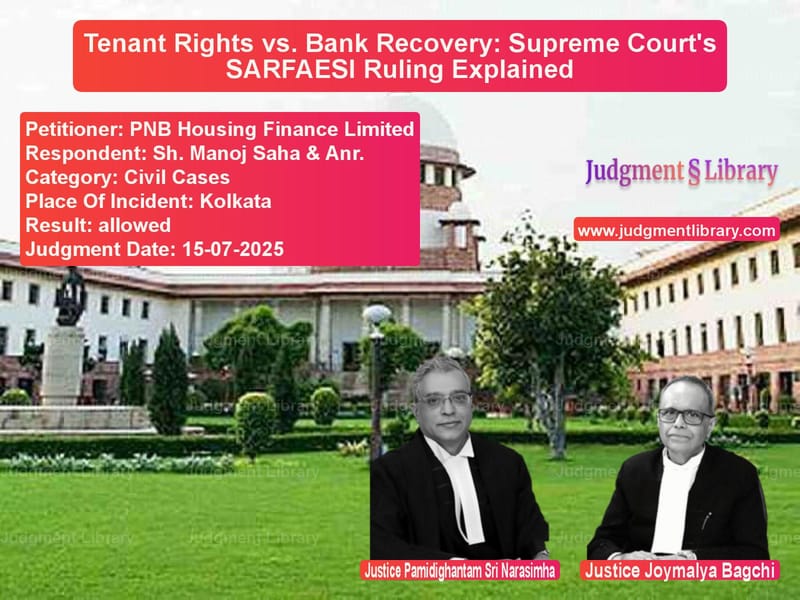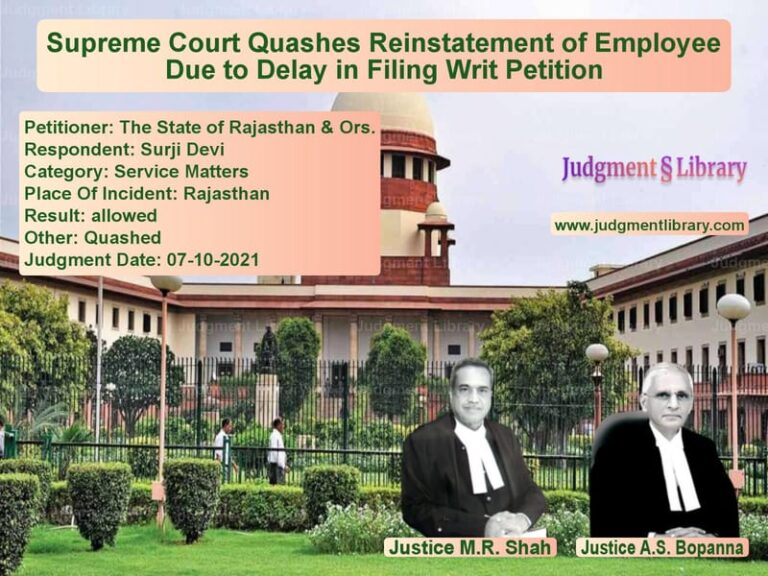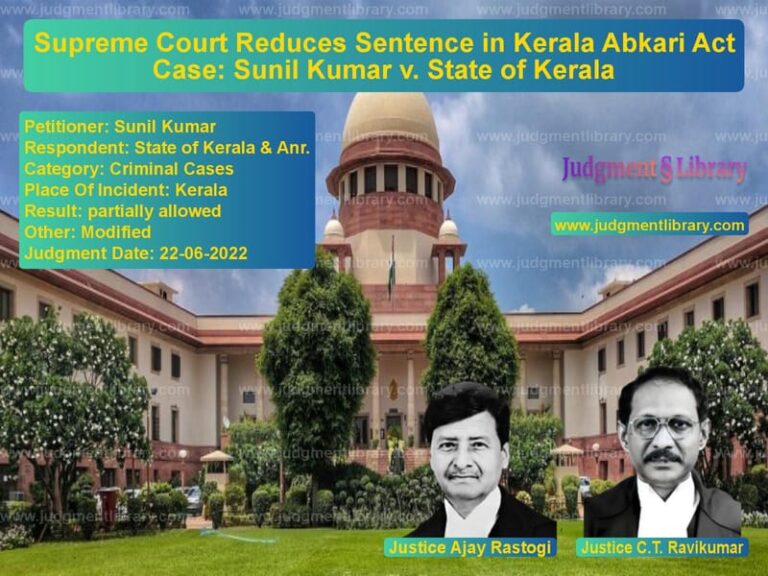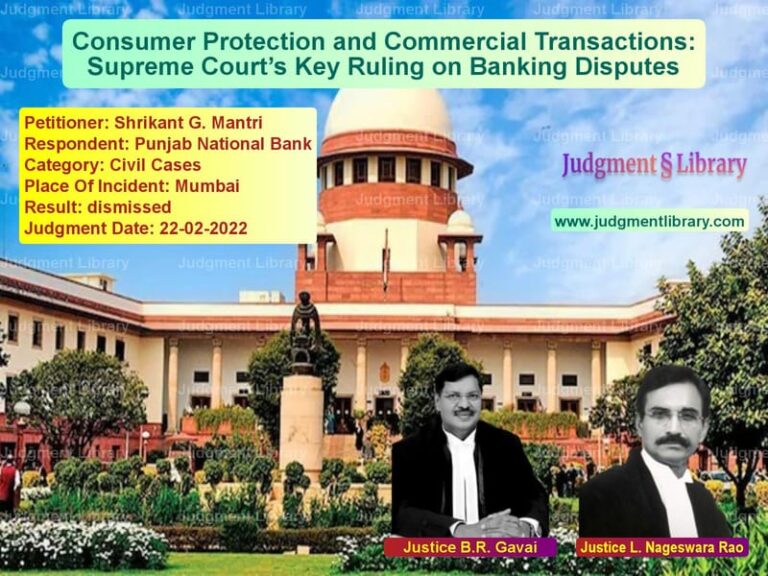Tenant Rights vs. Bank Recovery: Supreme Court’s SARFAESI Ruling Explained
The corridors of the Supreme Court recently witnessed a significant legal battle that pitted the rights of a long-term tenant against the recovery powers of a financial institution. The case, PNB Housing Finance Limited vs. Manoj Saha & Anr., revolved around a crucial question: can a bank, acting under a powerful recovery law, take possession of a property that is also someone’s home or place of business, especially when that person claims to be a lawful tenant? The judgment, delivered by a bench comprising Justices Pamidighantam Sri Narasimha and Joymalya Bagchi, delves deep into the complex interplay between tenancy rights protected under state laws and the sweeping powers granted to banks under the Securitisation and Reconstruction of Financial Assets and Enforcement of Security Interest Act, 2002 (SARFAESI Act).
The dispute concerned a 450 sq.ft. space on the first floor of a building at 1 Allenby Road in Kolkata. The first respondent, Mr. Manoj Saha, claimed to have been a tenant in this property since 1987, initially under a five-year unregistered lease agreement with the original landlord. After the lease expired in 1992, he alleged he continued as a monthly tenant. In 2007, the property was sold to the second respondent, who then called upon Mr. Saha to pay rent to him, which Mr. Saha claims he did.
The tranquil occupation of the premises was disrupted when the second respondent, the new owner, took loans from PNB Housing Finance Limited, using the property as security. When the loan account turned into a Non-Performing Asset (NPA), the bank issued a demand notice under Section 13(2) of the SARFAESI Act in July 2021. As no payment was made, the bank initiated recovery measures. It first took symbolic possession of the property in December 2021, publishing notices in newspapers and affixing one on the property itself. Later, with the assistance of the District Magistrate, the bank took physical possession of the secured asset on August 2, 2023.
It was only after the physical possession was taken that Mr. Saha sprang into action. He informed the bank of his tenancy and subsequently filed a securitization application before the Debt Recovery Tribunal (DRT), seeking the restoration of possession. The DRT, however, was not convinced at the interim stage. It noted that the claim of tenancy was based on an unregistered instrument and that neither the borrower nor the tenant had informed the bank about the tenancy at the time the mortgage was created. Relying on the precedent set in Harshad Govardhan Sondagar v. International Assets Reconstruction Company Limited, the DRT rejected the plea for interim relief.
Unsatisfied, Mr. Saha approached the High Court under Article 227 of the Constitution. The High Court took a different view. It repelled the bank’s argument that Mr. Saha should have availed himself of the alternative appellate remedy, and in a significant move, directed the restoration of possession to the tenant. The High Court observed, “Thus, the contention of the bank that there is an alternative remedy of appeal is not accepted by this court in the peculiar facts and circumstances of this case. By the order impugned, the right of the petitioner as canvassed in his SA, has been finally decided. A doctor who was in occupation of the premises and running his chamber, in my, prima facie, view could not be thrown away without due process of law. The issue whether the doctor was inducted as a valid tenant and/or whether his possession was legal or not, are matters which will be decided in the SA, but the occupation cannot be doubted, as available from the records. Under such circumstances, the interim prayer for use of the premises as a chamber ought to have been granted to the petitioner by the learned tribunal in lawful exercise of jurisdiction vested upon it, with certain conditions. Accordingly, the revisional application is allowed.” This decision of the High Court set the stage for the appeal before the Supreme Court by PNB Housing Finance.
The Bank’s Core Argument: The Existence of an Alternate Remedy
Before the Supreme Court, the appellant bank, represented by Mr. Suri, launched its attack on a fundamental procedural ground. It argued that the High Court ought not to have entertained the petition at all because a specific statutory remedy was available to Mr. Saha. The Supreme Court wholeheartedly agreed with this submission. The Court explained that the SARFAESI Act was amended in 2016, introducing Section 17(4A). This provision, effective from September 1, 2016, specifically allows any person claiming to be a tenant of a secured asset to approach the DRT to challenge the measures taken by a bank under Section 13(4) of the Act, which includes taking possession. Furthermore, an order from the DRT is appealable before the Appellate Tribunal under Section 18 of the Act.
In light of this comprehensive statutory framework, the Supreme Court has repeatedly discouraged High Courts from interfering in SARFAESI matters under their writ jurisdiction. The Court pointed out that the High Court had erroneously relied on the case of Harshad Govardhan Sondagar, which was decided under the pre-amended law where no such remedy for tenants existed before the DRT. “The observations in Harshad Govardhan Sondagar (supra) with regard to absence of statutory remedy available to a lessee/tenant to assail measures under section 13(4) before DRT is based on the pre-amended law and has no manner of application under the post amendment regime,” the Court clarified. Despite finding that the High Court should not have entertained the petition, the Supreme Court proceeded to examine the merits of the case since the High Court had already done so and passed a consequential order.
The Tenant’s Defense: Protected Tenancy and Constitutional Rights
Arguing for Mr. Saha, Mr. Gupta presented a defense centered on the sanctity of tenancy rights. He contended that his client had been inducted as a tenant in 1987 and was continuing as a monthly tenant. He emphasized that this tenancy was protected under the West Bengal Premises Tenancy Act, 1997, and that a tenant could only be evicted on the specific grounds enumerated in that Act. The recovery of possession by the bank, he argued, illegally extinguished this protected tenancy and deprived Mr. Saha of his constitutional right to property. This argument touched upon a long-standing legal conflict: the clash between the special protection afforded to tenants under various state rent control acts and the overriding power of the SARFAESI Act, which is designed to allow banks to quickly recover bad debts without getting entangled in prolonged legal processes.
The Legal Conundrum: SARFAESI vs. Rent Control Acts
The Supreme Court’s judgment provides a masterful analysis of the evolving jurisprudence on this very issue. The Court revisited its own landmark decisions to trace the legal landscape. In the 2014 case of Harshad Govardhan Sondagar, the Court had held that while Section 13(13) of SARFAESI overrides certain provisions of the Transfer of Property Act and invalidates leases created after a demand notice is issued, it does not automatically determine a prior lease created through a registered instrument. However, for a tenant claiming through an oral or unregistered agreement, the tenancy cannot exceed one year from the issuance of the notice, beyond which the tenant becomes a ‘tenant in sufferance’.
The plot thickened with the 2016 case of Vishal N. Kalsaria v. Bank of India, where the Court seemed to create an exception for tenancies protected under rent control acts. It held that the SARFAESI Act and rent laws operate in different fields and that the non-obstante clause (a clause that gives a law overriding effect) in SARFAESI could not be used to ‘bulldoze’ the statutory rights of tenants. “It is a settled position of law that once tenancy is created, a tenant can be evicted only after following the due process of law, as prescribed under the provisions of the Rent Control Act. A tenant cannot be arbitrarily evicted by using the provisions of the SARFAESI Act as that would amount to stultifying the statutory rights of protection given to the tenant. A non obstante clause (Section 35 of the SARFAESI Act) cannot be used to bulldoze the statutory rights vested in the tenants under the Rent Control Act,” the Court had observed in Vishal Kalsaria.
However, this position was subsequently reconsidered by a larger three-judge bench in Bajarang Shyamsunder Agarwal v. Central Bank of India in 2019. The three-judge bench expressed a different view on the scope of SARFAESI’s non-obstante clause. “While we agree with the principle laid out in Vishal N. Kalsaria case that the tenancy rights under the Rent Act need to be respected in appropriate cases, however, we believe that the holding with respect to the restricted application of the non obstante clause under Section 35 of the SARFAESI Act, to only apply to the laws operating in the same field is too narrow and such a proposition does not follow from the ruling of this Court in Harshad Govardhan case,” the bench stated.
The Bajarang judgment placed a significant onus on tenants claiming through oral or unregistered agreements. It clarified that such tenants must produce concrete evidence like rent receipts, tax payment records, or utility bills to prove a valid tenancy. Even if proven, such tenancies would not be allowed to continue beyond one year from the date of the bank’s demand notice under Section 13(2) of SARFAESI.
The Supreme Court’s Verdict and Reasoning
In the present case, the Supreme Court found it unnecessary to delve deeper into the theoretical conflict between SARFAESI and the Rent Act because it was not convinced by the evidence Mr. Saha had presented to prove his tenancy. This is the crux of the judgment and a critical lesson for any tenant facing a similar situation. Although Mr. Saha claimed to be a tenant since 1987, he failed to produce any rent receipts, tax receipts, or electricity bills that demonstrated his continuous occupation of the premises prior to the bank issuing its demand notice in July 2021. The only evidence he relied upon were documents showing the deposit of rent with the Rent Controller from January to December 2022—which was after the bank had initiated recovery proceedings.
The Court held that this was insufficient. “Mere reference to some pre-existing tenancy in the sale deed or issuance of letter of attornment by 2nd Respondent (who is also the borrower) unsubstantiated by independent and convincing possessory evidence would not establish a compelling case of pre-existing tenancy in favour of 1st Respondent,” the Court ruled.
The Court also took a dim view of Mr. Saha’s conduct. It noted that the bank had published notices of symbolic possession in December 2021 in newspapers and on the property itself, yet Mr. Saha took no steps to assert his rights. Even when a notice for taking physical possession was pasted on the property in July 2023, he remained passive. It was only after the bank had taken physical possession that he approached the DRT. The Court emphasized that a mandatory order restoring possession requires a ‘compelling cast iron case,’ which Mr. Saha had failed to establish. “His indifferent conduct and failure to produce rent receipts and/or other evidence regarding continued possession prior to issuance of demand notice under section 13(2) of SARFAESI does not justify a mandatory order,” the Court concluded.
Consequently, the Supreme Court allowed the bank’s appeal, set aside the High Court’s order directing restoration of possession, and directed that the status quo be maintained regarding the secured asset until the DRT finally disposes of the securitization application. It also directed the DRT to conclude the proceedings within two months.
The Last Word
The Supreme Court’s judgment in PNB Housing Finance vs. Manoj Saha serves as a powerful reminder of the importance of evidence and proactive legal action. While the law has evolved to provide a forum for tenants to challenge bank actions under SARFAESI, the onus is squarely on the tenant to not only have a legitimate claim but also to be able to prove it with contemporaneous documentary evidence. A claim of tenancy, especially one based on an unregistered agreement, cannot remain in the realm of oral assertion. It must be backed by solid proof like rent receipts, utility bills, and tax records that predate the bank’s claim on the property. Furthermore, tenants cannot afford to be complacent. They must vigilantly protect their rights by responding promptly to any public notices issued by banks during the recovery process. The judgment reinforces the balance that courts seek to maintain—protecting the legitimate rights of tenants while also acknowledging the need for banks to efficiently recover debts to maintain the health of the financial system. For now, the chamber at 1 Allenby Road remains in the bank’s possession, its ultimate fate awaiting the final word from the Debt Recovery Tribunal.
Petitioner Name: PNB Housing Finance Limited.Respondent Name: Sh. Manoj Saha & Anr..Judgment By: Justice Pamidighantam Sri Narasimha, Justice Joymalya Bagchi.Place Of Incident: Kolkata.Judgment Date: 15-07-2025.Result: allowed.
Don’t miss out on the full details! Download the complete judgment in PDF format below and gain valuable insights instantly!
Download Judgment: pnb-housing-finance-vs-sh.-manoj-saha-&-anr-supreme-court-of-india-judgment-dated-15-07-2025.pdf
Directly Download Judgment: Directly download this Judgment
See all petitions in Property Disputes
See all petitions in Landlord-Tenant Disputes
See all petitions in Debt Recovery
See all petitions in Lease Agreements
See all petitions in Judgment by P.S. Narasimha
See all petitions in Judgment by Joymalya Bagchi
See all petitions in allowed
See all petitions in supreme court of India judgments July 2025
See all petitions in 2025 judgments
See all posts in Civil Cases Category
See all allowed petitions in Civil Cases Category
See all Dismissed petitions in Civil Cases Category
See all partially allowed petitions in Civil Cases Category







